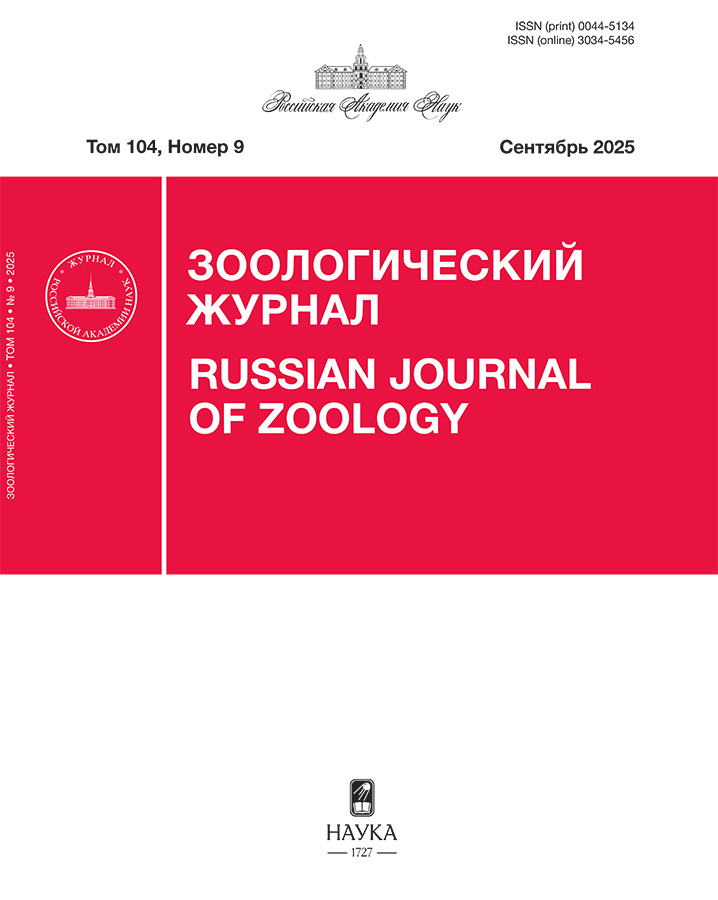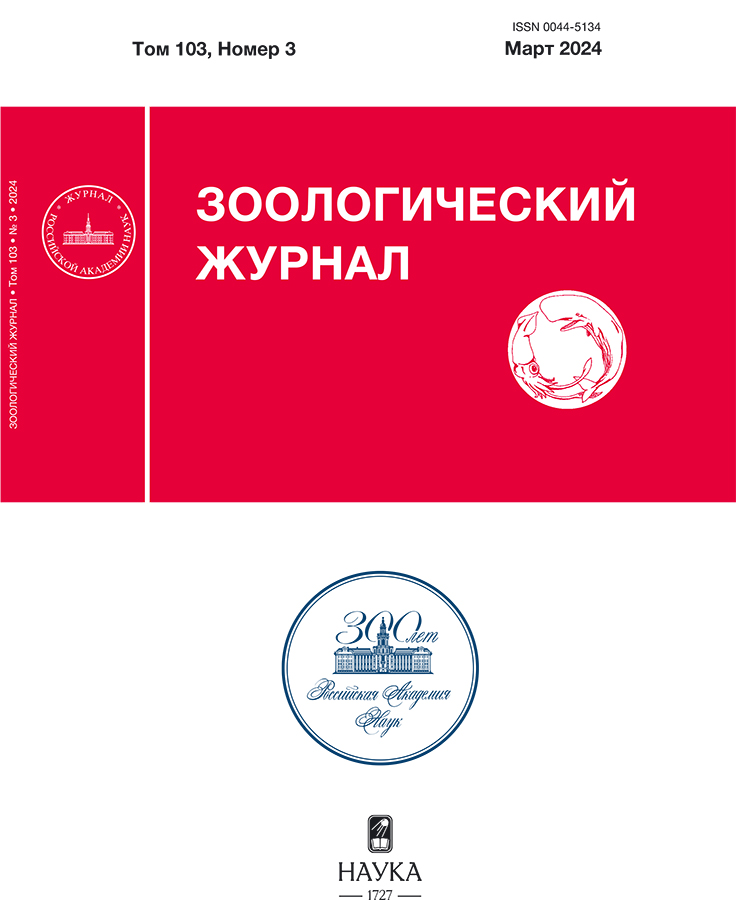Генетическая изменчивость и таксономический статус песчанки Даля (Meriones Dahli, rodentia, muridae)
- Авторы: Нанова О.Г.1, Лебедев В.С.1, Соловьева Е.Н.1, Лисенкова А.А.2, Богатырева В.Ю.1, Землемерова Е.Д.3, Матросова В.А.4
-
Учреждения:
- Московский государственный университет
- Московский государственный университет имени М. В. Ломоносова
- Институт проблем экологии и эволюции имени А.Н. Северцова Российской академии наук
- Институт молекулярной биологии имени В.А. Энгельгардта Российской академии наук
- Выпуск: Том 103, № 3 (2024)
- Страницы: 107-115
- Раздел: Статьи
- URL: https://archivog.com/0044-5134/article/view/654311
- DOI: https://doi.org/10.31857/S0044513424030116
- EDN: https://elibrary.ru/VNRIJD
- ID: 654311
Цитировать
Полный текст
Аннотация
Песчанка Даля (Meriones dahli) – вид, находящийся под угрозой исчезновения и обитающий на небольшой территории в центральном Закавказье. Филогенетическое положение песчанки Даля в пределах видового комплекса полуденных песчанок оценено с помощью анализа музейной ДНК. Исследовались последовательности как митохондриальных, так и ядерных генов. Мы обнаружили, что песчанка Даля является близкой сестринской группой к M. penicilliger, распространенной в Туране. Результат позволяет предположить существование в конце среднего плейстоцена коридора расселения псаммофильных видов, который соединял Закавказье и Закаспий.
Ключевые слова
Полный текст
Об авторах
О. Г. Нанова
Московский государственный университет
Автор, ответственный за переписку.
Email: nanovaolgag@gmail.com
Зоологический музей
Россия, Москва, 125009В. С. Лебедев
Московский государственный университет
Email: nanovaolgag@gmail.com
Зоологический музей
Россия, Москва, 125009Е. Н. Соловьева
Московский государственный университет
Email: nanovaolgag@gmail.com
Зоологический музей
Россия, Москва, 125009А. А. Лисенкова
Московский государственный университет имени М. В. Ломоносова
Email: nanovaolgag@gmail.com
кафедра зоологии позвоночных, биологический факультет
Россия, Москва, 119234В. Ю. Богатырева
Московский государственный университет
Email: nanovaolgag@gmail.com
Зоологический музей
Россия, Москва, 125009Е. Д. Землемерова
Институт проблем экологии и эволюции имени А.Н. Северцова Российской академии наук
Email: nanovaolgag@gmail.com
Россия, Москва, 119071
В. А. Матросова
Институт молекулярной биологии имени В.А. Энгельгардта Российской академии наук
Email: nanovaolgag@gmail.com
Лаборатория структурно-функциональной геномики
Россия, Москва, 119991Список литературы
- Alhajeri B.H., Steppan S.J., 2018. A phylogenetic test of adaptation to deserts and aridity in skull and dental morphology across rodents // Journal of Mammalogy. V. 99. № 5. P. 1197–1216. https://doi.org/10.1093/jmammal/gyy099
- Ananjeva N.B., Orlov N.L., Khalikov R.G., Darevsky I.S., Ryabov I.S., Barabanov A.V., 2006. An Atlas of the Reptiles of North Eurasia. Taxonomic Diversity, Distribution, Conservation Status // Pensoft Series Faunistica. V. 47. P. 1–250.
- Baker R.J., Bradley R.D., 2006. Speciation in mammals and the genetic species concept // Journal of Mammalogy. V. 87. № 4. P. 643–662. https://doi.org/10.1644/06-MAMM-F-038R2.1
- Bannikov A.G., Darevsky I.S., Rustamov A.K., 1971. Zemnovodniye i presmykayushchiesya SSSR (Amphibians and Reptiles of the USSR). Moscow: Mysl’. 304 p.
- Bulut Ş., Karacan G.O., 2021. Taxonomic status of Dahl’s Jird, Meriones dahli, as inferred from cytochrome b and IRBP gene sequences (Mammalia: Rodentia) // Zoology in the Middle East. V. 67. № 4. P. 283– 289. https://doi.org/10.1080/09397140.2021.1992835
- Bulut Ş., 2022. The present status, distribution, demography, and diet of the Dahl’s Jird // Brazilian Journal of Biology. V. 82. P. e237849. https://doi.org/10.1590/1519-6984.237849
- Clark A.G., 1990. Inference of haplotypes from PCR-amplified samples of diploid populations // Molecular Biology and Evolution. V. 7. № 2. P. 111–122. https://doi.org/10.1093/oxfordjournals.molbev.a040591
- Dando T. Meriones dahli. The IUCN Red List of Threatened Species 2021: e.T13162A22433617 [Electronic resource]. Access: https://dx.doi.org/10.2305/IUCN.UK.2021-3.RLTS.T13162A22433617.en. Accessed October 17, 2023.
- Drummond A.J., Suchard M.A., Xie D., Rambaut A., 2012. Bayesian phylogenetics with BEAUti and the BEAST 1.7 // Molecular Biology and Evolution. V. 29. № 8. P. 1969–1973. https://doi.org/10.1093/molbev/mss075
- Dyatlov A.I., Avanyan L.A., 1987. Substantiation of the species rank for two subspecies of jirds (Meriones, Cricetidae, Rodentia) // Russian Journal of Zoology. V. 66. P. 1069– 1074.
- Excoffier L., Lischer H.E., 2010. Arlequin suite ver. 3.5: a new series of programs to perform population genetics analyses under Linux and Windows // Molecular Ecology Resources. V. 10. № 3. P. 564–567. https://doi.org/10.1111/j.1755-0998.2010.02847.x
- Gromov I.M., Erbajeva M.A., 1995. Mlekopitayushchie fauny Rossii i sopredel’nyh territorii. Zaitseobraznye i gryzuny (Mammals of the Fauna of Russia and Adjacent Territories. Lagomorphs and Rodents) // Opredeliteli po faune Rossii (Identification Guide to the Fauna of Russia). № 167. St. Petersburg: Zoological Institute of Russian Academy of Sciences. 520 p.
- Hall T.A., 1999. BioEdit: a user-friendly biological sequence alignment editor and analysis program for Windows 95/98/NT // Nucleic acids symposium series. V. 41. № 41. P. 95–98.
- Heptner V.G., 1945. Desert-steppe fauna of Palearctic and centers of its formation // Bulletin of Moscow Society of Naturalists. Biological series. V. 50. P. 17–38.
- Heptner V.G., 1968. Some theoretical aspects of conceptions of subspecies, subspecies’ traits and borders of range by the example of geographical variability of two palearctic mammal species // Proceedings of Zoological Museum MSU. V. 10. P. 3–36.
- Ho S.Y., Phillips M.J., Cooper A., Drummond A.J., 2005. Time dependency of molecular rate estimates and systematic overestimation of recent divergence times // Molecular Biology and Evolution. V. 22. № 7. P. 1561–1568. https://doi.org/10.1093/molbev/msi145
- Hosseinian Yousefkhani S.S., Rastegar-Pouyani E., Aliabadian M., 2016. Ecological niche differentiation and taxonomic distinction between Eremias strauchi strauchi and Eremias strauchi kopetdaghica (Squamata: Lacertidae) on the Iranian Plateau based on ecological niche modeling // Italian Journal of Zoology. V. 83. № 3. P. 408–416. https://doi.org/10.1080/11250003.2016.1209581
- Korobitsyna K.V., 1969. Vnutrividovaya izmenchivost’ hromosom nekotoryh peschanok (Meriones, Gerbillinae, Cricetidae, Rodentia), (Intraspecific variability of chromosomes of some species of gerbils (Meriones, Gerbillinae, Cricetidae, Rodentia)) // Mlekopitayushchie: evolutsiya, kariologiya, sistematika, faunistika: materialy ko II-omu Vses. soveshch. po mlekopitayushchim (Mammals: Evolution, Karyology, Taxonomy, Fauna: Materials for the II All-Union Mammology Confer.), Novosibirsk. P. 117– 120.
- Kalyaanamoorthy S., Minh B.Q., Wong T.K., Von Haeseler A., Jermiin L.S., 2017. ModelFinder: fast model selection for accurate phylogenetic estimates // Nature Methods. V. 14. № 6. P. 587–589. https://doi.org/10.1038/nmeth.4285
- Leigh J.W., Bryant D., 2015. POPART: full-feature software for haplotype network construction // Methods in Ecology and Evolution. V. 6. № 9. P. 1110–1116. https://doi.org/10.1111/2041-210X.12410
- Minh B.Q., Nguyen M.A.T., Von Haeseler A., 2013. Ultrafast approximation for phylogenetic bootstrap // Molecular Biology and Evolution. V. 30. № 5. P. 1188– 1195. https://doi.org/10.1093/molbev/mst024
- Nanova O., 2014. Geographical variation in the cranial measurements of the midday jird Meriones meridianus (Rodentia: Muridae) and its taxonomic implications // Journal of Zoological Systematics and Evolutionary Research. V. 52. № 1. P. 75–85. https://doi.org/10.1111/jzs.12032
- Nanova O.G., Lebedev V.S., Matrosova V.A., Adiya Y., Undrakhbayar E., Surov A.V., Shenbrot G.I., 2020. Phylogeography, phylogeny, and taxonomical revision of the Midday jird (Meriones meridianus) species complex from Dzhungaria // Journal of Zoological Systematics and Evolutionary Research. V. 58. № 4. P. 1335–1358. https://doi.org/10.1111/jzs.12372
- Nguyen L.-T., Schmidt H.A., Von Haeseler A., Minh B.Q., 2015. IQ-TREE: a fast and effective stochastic algorithm for estimating maximum-likelihood phylogenies // Molecular Biology and Evolution. V. 32. № 1. P. 268–74. https://doi.org/10.1093/molbev/msu300
- Pavlinov I. Ya., 1990. Kladisticheskiy analiz (metodologicheskie problemy) (Cladistic Analysis (Methodological Problems)). Moscow: Moscow Univ. Publ. 160 p.
- Sahakyan L.V., Fayvush G.M., Kalashian M.Y., 2009. The current status of Dahl’s jird (Meriones dahli Shidlovski, 1962) // Status and Protection of Globally Threatened Species in the Caucasus. Zazanashvili N. and Mallon D., Eds. Tbilisi: CEPF, WWF. Contour Ltd. P. 111–116.
- Shidlovsky M.V., 1962. Opredelitel’ gryzunov Zakavkaz’ya (Key to Rodents of the Transcaucasus), 2nd ed. Tbilisi: Metzniereba. 195 p.
- Wilson D.E., Lacher T.E., Mittermeier R.A. (eds), 2017. Handbook of the Mammals of the World. Vl. 7. Rodents II. Barcelona: Lynx Edicions. 1008 p.
- Zaitsev M.V., Voita L.L., Sheftel B.I., 1995. Mlekopitayushchie fauny Rossii I sopredel’nyh territorii. Nasekomoyadnye (The Mammals of Russia and Adjacent Territories. Lipotyphlans) // Opredeliteli po faune Rossii (Identification Guide to the Fauna of Russia). № 178. St. Petersburg: Zoological Institute of Russian Academy of Sciences. 390 p.
Дополнительные файлы














